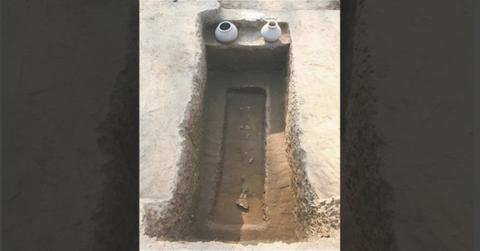Digging Deep: Farmers in China Removing Soil for Agricultural Use Uncover Ancient Tombs

The ancient tombs were discovered after farmers worked to remove soil from the land.
On a high plateau where two rivers and a lake converge in eastern China, developers ready for a new construction project prepared an open plain to begin work.
When surveyors examined the plain, however, they found it to be irregular with soil layers of varying thickness.
Archaeologists conducted exploratory digs, and they unearthed shards of pottery and porcelain as well as plant ash and shells, the Jinan Archaeological Research Institute noted.
Local residents revealed that for decades, particularly during the 1960s and 1970s, farmers had been extracting soil from the plain for agricultural use. Their actions inadvertently exposed what lay beneath: a vast ancient cemetery.
Over time, the farmers had removed about 10 feet of soil. A network of tombs was discovered just 5 feet below the surface, according to the institute.
Further excavations revealed tombs from multiple dynasties at different depths. A total of 241 tombs, 101 burn pits, two burn ditches, two wells and one stove were identified, spanning 10 different time periods, according to the institute.
Some tombs date back to the Longshan Dynasty, which spanned 2600 to 2000 B.C., while others are from the Han Dynasty nearly 2,000 years later, researchers said.
In the older tombs, archaeologists found copper mirrors, coins, ornaments, spears, iron plows, swords, various pottery vases, plates and lacquerware tiles. The newer tombs, many from the Warring States Period (475 to 221 B.C.), contained jars, beans, bowls, cups and spears atop brick tombs.
- What Lies Beneath: NASA Scientist Believes Aliens May Have Found 'Perfect' Hiding Spot in Earth's Oceans
- Global Threat: Russia Insider Warns West of 'World War Using Nuclear Weapons' Amid Escalating Support for Ukraine
- Countdown to Disaster? Ex-NATO Official Warns Russia, Iran and China Could Wage WWIII in Just Years
One knife-handle-shaped tomb contained 50 tricolor pieces and more than 20 porcelain items, the researchers reported.
Archaeologists also uncovered circular or elliptical burn or ash pits made of gray and black soil.
Never miss a story — sign up for the Front Page Detectives newsletter. Be on the scene the moment news breaks.
This burial site was once adjacent to the ancient city of Jinan, but the city was later relocated to the west.
Historical records show that the original Jinan was established during the Song Dynasty, though its exact location during the Jin and Tang dynasties remains unknown, according to the release.
This discovery will aid archaeologists in their quest to locate the original site of the city, researchers said.
Become a Front Page Detective
Sign up to receive breaking
Front Page Detectives
news and exclusive investigations.
